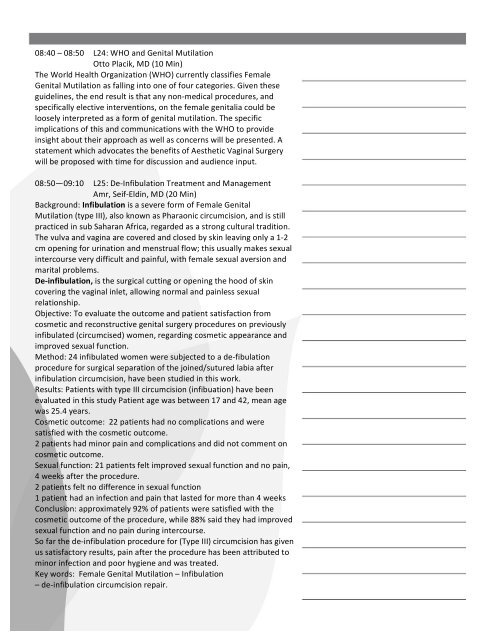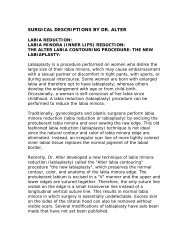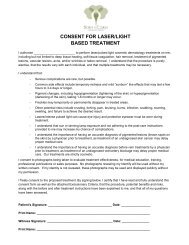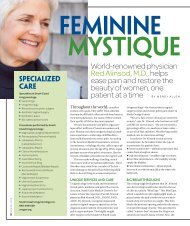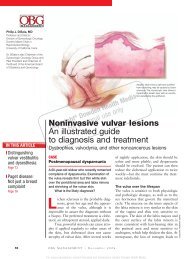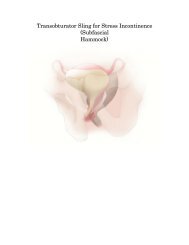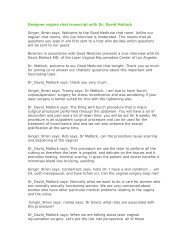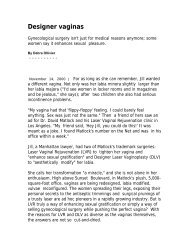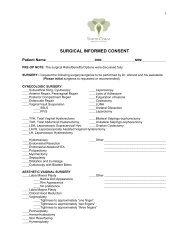You also want an ePaper? Increase the reach of your titles
YUMPU automatically turns print PDFs into web optimized ePapers that Google loves.
08:40 – 08:50 L24: WHO and Genital Mutilation <br />
Otto Placik, MD (<strong>10</strong> Min) <br />
The World Health Organization (WHO) currently classifies Female <br />
Genital Mutilation as falling into one of four categories. Given these <br />
guidelines, the end result is that any non-‐medical procedures, and <br />
specifically elective interventions, on the female genitalia could be <br />
loosely interpreted as a form of genital mutilation. The specific <br />
implications of this and communications with the WHO to provide <br />
insight about their approach as well as concerns will be presented. A <br />
statement which advocates the benefits of Aesthetic Vaginal Surgery <br />
will be proposed with time for discussion and audience input. <br />
08:50—09:<strong>10</strong> L25: De-‐Infibulation Treatment and Management <br />
Amr, Seif-‐Eldin, MD (20 Min) <br />
Background: Infibulation is a severe form of Female Genital <br />
Mutilation (type III), also known as Pharaonic circumcision, and is still <br />
practiced in sub Saharan Africa, regarded as a strong cultural tradition. <br />
The vulva and vagina are covered and closed by skin leaving only a 1-‐2 <br />
cm opening for urination and menstrual flow; this usually makes sexual <br />
intercourse very difficult and painful, with female sexual aversion and <br />
marital problems. <br />
De-‐infibulation, is the surgical cutting or opening the hood of skin <br />
covering the vaginal inlet, allowing normal and painless sexual <br />
relationship. <br />
Objective: To evaluate the outcome and patient satisfaction from <br />
cosmetic and reconstructive genital surgery procedures on previously <br />
infibulated (circumcised) women, regarding cosmetic appearance and <br />
improved sexual function. <br />
Method: 24 infibulated women were subjected to a de-‐fibulation <br />
procedure for surgical separation of the joined/sutured labia after <br />
infibulation circumcision, have been studied in this work. <br />
Results: Patients with type III circumcision (infibuation) have been <br />
evaluated in this study Patient age was between 17 and 42, mean age <br />
was 25.4 years. <br />
Cosmetic outcome: 22 patients had no complications and were <br />
satisfied with the cosmetic outcome. <br />
2 patients had minor pain and complications and did not comment on <br />
cosmetic outcome. <br />
Sexual function: 21 patients felt improved sexual function and no pain, <br />
4 weeks after the procedure. <br />
2 patients felt no difference in sexual function <br />
1 patient had an infection and pain that lasted for more than 4 weeks <br />
Conclusion: approximately 92% of patients were satisfied with the <br />
cosmetic outcome of the procedure, while 88% said they had improved <br />
sexual function and no pain during intercourse. <br />
So far the de-‐infibulation procedure for (Type III) circumcision has given <br />
us satisfactory results, pain after the procedure has been attributed to <br />
minor infection and poor hygiene and was treated. <br />
Key words: Female Genital Mutilation – Infibulation <br />
– de-‐infibulation circumcision repair. <br />
<br />
13


